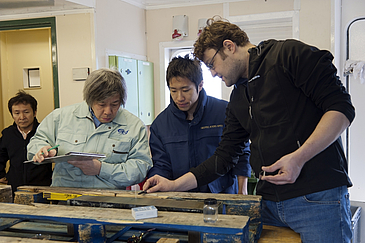On the afternoon of 11th March 2011, the earth off the coast of the Japanese region of Tohoku quaked for a full 150 fateful seconds. Registering 9 on the Richter Scale, the severe seaquake triggered a tragic Tsunami that devastated large parts of the coastline and cost the lives of more than 15,000 people. The August issue of “Geology” features a report by a European-Japanese research team on the impact the quake has had on the bottom of the ocean. On the slope of the 7.5 km-deep Japan trench at least 28 square kilometers of sea floor was abruptly plunged into the depths. Nearer the surface, two tectonic plates were shifted an astonishing three kilometers to the East.
Immediately following this catastrophic event, on the Island of Honshu a group of Japanese and European earth scientists began planning an expedition to investigate the impact of the quake. At the same time, in February/March 2012 a German-Japanese expedition team led by MARUM director Professor Gerold Wefer and funded by the Federal German Government (BMBF) and the German Research Society (DFG) was on the research vessel SONNE. They set themselves the task to take sediment core samples and chart the seabed east of the epicenter. The two expedition teams present their initial findings in the latest issue “Geology”.
The expeditions set off to explore the areas where the Pacific plate submerges under the Ochotsk plate with its ring of volcanoes. Before they started on the expedition, the researchers already knew that the Tohoku quake had caused a 400-kilometer split in the earth’s crust near Honshu, forcing parts of the coastline up to five meters in an easterly direction. Along the edge of the Japan trench parts of the earth’s crust were shifted by more than 50 meters. It was still unknown, though, what the impact had been on the 7.5 Km deep trench itself.
To find out more about the transformation of the seabed, the expedition team drilled several, nearly nine-meter-long sediment cores from water depths of around 7.5 kilometers in the Japan trench. "The sediment layers deposited through the ages had remained largely undisturbed," says Michael Strasser from the ETH Zurich. “We therefore conclude that the quake did not cause any large chaotic slide of the sediment masses into the depths of the Japan trench.” The researchers found evidence of only a few such incidences of such turbulent transportation and shifted sediments.
In a further stage the researchers analyzed the pore water trapped in the sediment cores and their sulfate concentrations: “On an undisturbed seabed the sulfate content decreases linearly with increasing sediment depth. This is precisely what we found in a number of our samples“, says Dr. Martin Kölling, a MARUM geochemist. Some of the turbulently transported sediments allowed the researchers to create models chronicling the shifts in the Japan trench: They must have occurred quite recently and therefore probably have something to do with the Tohoku earthquake.
“Based on our investigations we can conclude that the sudden and violent 50-meter shift in the earth’s crust caused by the quake led to large sediment packets breaking off from the edge of the Japan trench”, explains Michael Strasser. “At some places the falling sediments piled up on the ocean floor, causing hills and troughs on the floor of the Japan trench.”
One of the research team’s findings is really quite incredible: Nearer the surface, the movement of sediment masses caused the Eurasian plate to shift almost three kilometers to the East! “Earth scientists are more used to thinking in categories of hundreds of thousands or even millions of years”, says Professor Gerold Wefer. “The expedition’s findings have taught us that events like these can cause the boundaries of tectonic plates to be radically altered within a matter of minutes or even seconds.“
For more information, please contact:
Universität Bremen
MARUM
Jana Stone
MARUM-Öffentlichkeitsarbeit
Phone: +49 421 218 65541
email: jstoneprotect me ?!marumprotect me ?!.de
www.marum.de
https://twitter.com/marum_de

